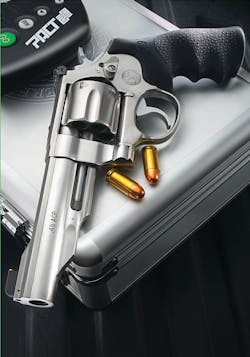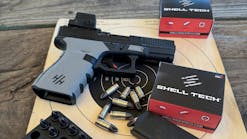The firearms future: cartridges, crime stats and zombie shoots
The trend in handguns has gone to multiple options like the FNX45, which allows hammer up or hammer down carry, to every manufacturer out there producing a 1911 style 45. The FNX 45 has excellent recoil control and ergonomics, opening the door toward using this as a competition handgun.
I had a chance to shoot the Ruger SR1911 and I found this model was faithful to the original design, while consistent with the Ruger label of quality and reasonable pricing.
Ammunition
The most notable of firearm trends this year has been a marked improvement in already effective cartridges. The long standing manufacturers have been steadily improving design for accuracy and terminal performance. This has changed the nature of inquiries (yes, readers ask “what should I carry?” all the time) to smaller and smaller off duty options. I always steer them toward duty calibers like 9mm, .40 and .45. However, I am not a fan of waist packs, unless hiking is on the agenda, and therefore recommend pocket pistols.
This year, Hornady and Winchester have made the .380 ACP more promising. Hornady's .380 90-grain FTX cartridge (90080) and Winchester's 380 Auto 95 gr. PDX1 Defender (S380PDB) can do what was expected of 9mm cartridges several years ago.
This has spurred the uptick of quality guns that take .380 cartridges. The Colt 380 Mustang Pocketlite is back. This handgun has all of the quality of its famous brethren, but weighs in at 12.5 ounces. In an unintended coincidence, the gun whose quality and configuration rivals the Colt is the SIG P238 also takes similar magazines. I'm saying similar because the magazines share similar dimensions. Both guns will seat and operate with them. I'll let readers make up their own minds.
Again, I try to steer officers to duty sized cartridges, but tiny guns go with running shorts. Since I carried a North American Arms revolver [somewhere on my person] as [another] backup, I have to recommend the new Hornady 22 WMR 45-grain FTX Critical Defense cartridge, which will beat the “no gun” option anytime. ipad users can view the video by clicking the link.
Charter Arms CARR
Charter Arms has mastered the rimless revolver. The Charter Arms Rimless Revolver (CARR) is an excellent choice for officers who carry an auto for primary and use a revolver off duty. The CARR also allows some officers to comply with certain cartridge policies for off duty/backup carry. Charter Arms has a 9mm and .40 model out now. They plan to introduce a .45 version in the future.
The CARR is unique because its special spring detent system does not require rimless adapters commonly called moon clips. When I tried the .40 model out, I found it had a natural point, good ergonomics and smooth cartridge insertion and extraction. Engineering wise, this innovation is at the same level as the Ruger LCR (absolutely brilliant!) and the original introduction of the Dan Wesson 715V.
Law enforcement matches
There seems to be a renewed interest in law enforcement officers attending competitive matches, especially three-gun matches. If readers saw the LET October issue, there should be no question that I am all for it.
Many officers have been holding matches open to only active, retired, reserve or affiliated personnel. This is a great practice to reduce the likelihood of creating a training deficiency in order to win the competition. Closed matches also give vendors an opportunity to let officers see new products specific to law enforcement like suppressors, restraints and thermal sights.
Some product manufacturers have responded to the call. For example PACT has introduced the Club Timer III, an affordable timer that agencies can use for practice and competition.
Crime statistics
The murder rate is up in many major cities. Nationally, the violent crime rate is down. The political response to this is to tighten restrictions on guns to reduce gun crimes. The other strategy proposal is to heavily tax the sale of bullets. The legislators really aren't reaching deep enough in their anti-crime efforts. Really, why don't they just make crime illegal?
None of the analysts out there predict any significant changes in gun laws post-elections. By the time this is published, November elections will have been decided. However, in the political fury that follows, all bets are off.
Why is this significant in a firearms column? Experts are only addressing the symptoms of violent crimes, not some of the social ills responsible for them. There is a cycle: People who attribute legal gun ownership as part of the crime problem push for more restrictions. Firearms become more restricted to persons who would acquire them legally. Crime statistics do not reflect the original intent of those who restricted ownership. People attribute legal gun ownership to part of the crime problem.
The policing issue that needs to be addressed here is a renewed application of social organization, which looks politically like an increase in social contracts. The basic principle of Community Policing is the fact that the police cannot solve the crime problem alone. The community has to partner with law enforcement and social institutions to reduce crime. The litmus test is when informal social institutions begin to work.
The problem with high crime areas? Informal institutions have to generally trust the government enough to partner with it, not rely on the government to resolve the problem. This collective efficacy has its most successful application under mayor Giuliani's (and Chief William Bratton's) massive social experiment, the application of Broken Windows. Although the uninspired have reduced this theory to “zero tolerance” the real power is collective efficacy.
Zombies, my favorite trend
My favorite trend has benefited civilian and law-enforcement firearms training alike. It seems that everyone has been preparing for a zombie invasion of one kind or another. This, of course, has been popularized by recent television shows like AMC's The Walking Dead.
Reputable gun schools have taken this concept and added preparation for zombie invasion to their repertoire of classes. It makes perfect sense. Most zombie experts know that body shots are generally ineffective but they have a tendency to slow them down. Therefore, training for the zombie invasion teaches students failure drills.
Some of the schools in my area have been using Zombie Industries’ reactive targets for some drills and their paper targets for others. This kind of stuff has added to the enthusiasm of target training, which adds to the pool of safe firearm users. There are two schools of thought here. Some might find it distasteful to use Zombie targets for training. Others find it to be a redirect from actually using human torso targets. Regardless, it has improved the overall efficacy of shooters and I think it is a viable trend.
The CDC has taken the zombie thing seriously also. Recently, the Halo Corp has been contracted to train about 1000 military and governmental personnel in the coming zombie invasion. Although this could be taken as tongue-in-cheek, it is actually a serious multiagency multi-hazard drill approach. Given the Halo Corporations reputation for excellent training, I would like to see this one myself. The CDC has even produced a novella called "Preparedness 101: Zombie Pandemic”. Anyone who wishes to read up on the zombie invasion, try Surviving the Zombies: Things the CDC Didn't Know by Frank Borrelli.
I guess the other benefit here is fitness. There are several sponsors who have produced some great fitness runs the include zombies, which runners must avoid. By this time, everyone knows that I am a believer in fitness and firearms training. After all, I do actually drive an official Zombie Escape Vehicle. The only difference between mine and the real thing is I got the one that will hold a full-size rifle.
I wish everyone the best for the holiday season. I'll see you all at the 2013 SHOT Show.

Officer Lindsey Bertomen (ret.), Contributing Editor
Lindsey Bertomen is a retired police officer and retired military small arms trainer. He teaches criminal justice at Hartnell College in Salinas, California, where serves as a POST administrator and firearms instructor. He also teaches civilian firearms classes, enjoys fly fishing, martial arts, and mountain biking. His articles have appeared in print and online for over two decades.



